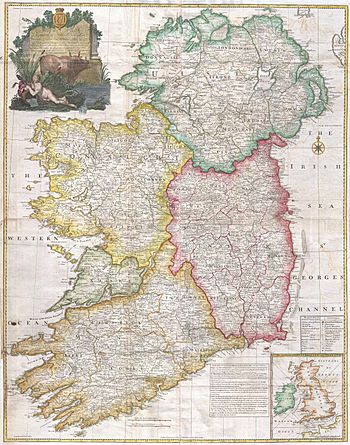Irish Republic (1798) facts for kids
Quick facts for kids
Irish Republic
|
|||||||||
|---|---|---|---|---|---|---|---|---|---|
| 1798 | |||||||||

1794 map of Ireland
|
|||||||||
| Status | Sister republic of the French Republic | ||||||||
| Common languages | Irish, English | ||||||||
| Government | Presidential federal republic | ||||||||
| President | |||||||||
|
• 1798
|
John Moore | ||||||||
| Historical era | French Revolutionary Wars | ||||||||
|
• Arrival of French forces
|
22 August 1798 | ||||||||
|
• Appointment of John Moore as president
|
31 August 1798 | ||||||||
|
• Storming of Killala
|
23 September 1798 | ||||||||
| Currency | Irish pound | ||||||||
|
|||||||||
| Today part of | Ireland | ||||||||
The Irish Republic of 1798 was a very short-lived country. It is also known as the Republic of Connacht. This republic was declared during the Irish Rebellion of 1798. This rebellion happened because of the French Revolutionary Wars.
The Irish Republic was like a "sister republic" to the French Republic. In theory, it was supposed to cover all of Ireland. However, it only really controlled small parts of the area called Connacht. Most of Ireland, including big cities like Dublin, Belfast, and Cork, was controlled by British forces.
Declaring the Republic
During the 1798 rebellion, about 1,000 French soldiers arrived in Ireland. They were led by General Jean Joseph Amable Humbert. They landed at a place called Killala in County Mayo.
General Humbert declared the Irish Republic on August 22, 1798. He made a special announcement to the people when he landed.
LIBERTY, EQUALITY, FRATERNITY, UNION, After several unsuccessful attempts, behold at last Frenchmen arrived amongst you... Union, Liberty, the Irish Republic! Such is our shout. Let us march. Our hearts are devoted to you; our glory is in your happiness.
After the new republic won a battle at Battle of Castlebar on August 27, 1798, General Humbert made another important announcement. This was on August 31, 1798. In this announcement, he named John Moore as the President of the Government for the area of Connacht.
Army Of IrelandLiberty, Equality
Head quarters at Castlebar, 14th Fructidor, sixth Year of the French Republic, One and Indivisible.
General Humbert, Commander in Chief of the Army of Ireland, desirous of organising with the least possible delay, an administrative power for the Province of Connaught, decrees as follows:
— General Humbert, Commanding-in-Chief
- The Government of the Province of Connaught shall reside at Castlebar till further orders.
- The Government shall be composed of twelve members, who shall be named by the General-in-chief of the French Army.
- Citizen JOHN MOORE is named President of the Government of the Province of Connaught, he is specially entrusted with the nomination and reunion of the members of the Government.
- The Government shall occupy itself immediately in organising the Military power of the Province of Connaught, and with providing subsistence for the French and Irish Armies.
- There shall be organised eight regiments of infantry, each of twelve hundred men, and four regiments of cavalry, each of six hundred men.
- The Government shall declare rebels and traitors to the country all those who having received clothing and arms, shall not join the army within four and twenty hours.
- Every individual from sixteen years of age to forty, inclusive, is REQUIRED in the name of the Irish Republic, to betake himself instantly to the French Camp, to march in a mass against the common enemy, the Tyrant of ANGLICIZED IRELAND, whose destruction alone can establish the independence and happiness of ANCIENT HIBERNIA.
President Moore quickly started to do things for the new republic. One thing he did was to print "paper money" for people to use. This money was issued "in the name of the French Government."
The Republic's Defeat
The Irish Republic of 1798 did not last long. It collapsed on September 8, 1798. This was just weeks after it was declared. The end came after the Battle of Ballinamuck.
John Moore, the president, was captured by government troops in Castlebar. He died while he was still being held the next year. General Humbert and his French soldiers were sent to Dublin. From there, they were exchanged for British prisoners of war.
After the battle, government forces moved into the areas that had been part of the republic. They fought many small battles with rebels who were still resisting. These actions ended on September 23, 1798, when Killala was captured by government forces. During this time, people suspected of being rebels were often punished severely. Many houses believed to be hiding rebels were burned.
Some rebels went into the countryside and continued to fight. They used guerrilla tactics, which means they fought in small groups. It took the government forces several months to finally stop these rebel groups.




